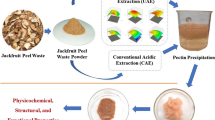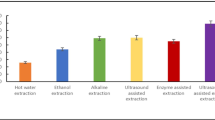Abstract
Purpose
The aim of the study was to evaluate the functional properties of dietary fibre extracted by different extraction techniques from the defatted seeds of yellow passion fruit (DPFS) and valorize this by-product of the passion fruit juice industry as food ingredient.
Materials and Methods
In order to extract dietary fibre (DF) from DPFS, the ultrasound-alkali extraction method (1% NaOH, ultrasonic probe with extraction time: 10–30 min, solid–liquid ratio: 5–20 g/100 mL, and power: 100–300 W) was contrasted with the conventional alkali extraction method (1% NaOH at 50 °C for 30 min) and distilled water-based ultrasonication extraction method. The characterization and physicochemical and functional qualities of the extracted dietary fibre were investigated. The functional properties including glucose absorption activity, amylase inhibitory activity, and cytotoxicity assay were also evaluated. Utilizing response surface methodology approach, the settings for dietary fibre extraction employing ultrasonic and alkaline solutions were optimised.
Results
The alkaline extraction yielded 52.8% DF, and ultrasonication for 90 min yielded 50.4% whereas the alkaline-ultrasonic method yielded 61.35% at the optimized condition. Ultrasonication treatment enhanced the functional quality of DF by increasing the water-holding (2.2–2.9 g/g), oil-holding (3.4–4.1 g/g), and swelling capacities (7.5–15.7 mL/g) and decreasing the cation exchange capacity (54.3–53.2 (meq/kg). Glucose adsorption capacity (9.5–18.3 mmol glucose/g fibre), α-amylase activity, and emulsion capacity (38.9–50.1%) were improved significantly by ultrasound. Cytotoxicity study revealed that toxicity increased during ultrasonication, but within the acceptable limit.
Conclusion
The findings demonstrated that DPFS waste has a high potential for use in food processing as a functional food ingredient.
Graphical Abstract







Similar content being viewed by others
Data Availability
Data will be made available on reasonable request.
References
Pereira, M.G., Hamerski, F., Andrade, E.F., Scheer, A.D.P., Corazza, M.L.: Assessment of subcritical propane, ultrasound-assisted and Soxhlet extraction of oil from sweet passion fruit (Passiflora alata Curtis) seeds. J. Supercrit. Fluids 128, 338–348 (2017). https://doi.org/10.1016/j.supflu.2017.03.021
Corrêa, R.C., Peralta, R.M., Haminiuk, C.W., Maciel, G.M., Bracht, A., Ferreira, I.C.: The past decade findings related with nutritional composition, bioactive molecules and biotechnological applications of Passiflora spp. (passion fruit). Trends Food Sci. Technol. 58, 79–95 (2016). https://doi.org/10.1016/j.tifs.2016.10.006
Thokchom, R., Mandal, G.: Production preference and importance of passion fruit (Passiflora Edulis): a review. J. Agric. Eng. Food Technol. 4(1), 27–30 (2017)
Ramaiya, S.D., Bujang, J.B., Zakaria, M.H., Saupi, N.: Nutritional, mineral and organic acid composition of passion fruit (Passiflora species). Food Res. 3(3), 231–240 (2019). https://doi.org/10.26656/fr.2017.3(3).233
Santos, J.T., Petry, F.C., de Castro Tobaruela, E., Mercadante, A.Z., Gloria, M.B.A., Costa, A.M., Hassimotto, N.M.A.: Brazilian native passion fruit (Passiflora tenuifila Killip) is a rich source of proanthocyanidins, carotenoids, and dietary fiber. Food Res. Int. 147, 110521 (2021). https://doi.org/10.1016/j.foodres.2021.110521
Oliveira, C.F., Gurak, P.D., Cladera-Olivera, F., Marczak, L.D.F.: Evaluation of physicochemical, technological and morphological characteristics of powdered yellow passion fruit peel. Int. Food Res. J. 23(4), 1652–1663 (2016)
Chau, C.F., Huang, Y.L.: Characterization of passion fruit seed fibres —A potential fibre source. Food Chem. 85, 189–194 (2004). https://doi.org/10.1016/j.foodchem.2003.05.009
dos Reis, L.C.R., Facco, E.M.P., Salvador, M., Flôres, S.H., de Oliveira Rios, A.: Antioxidant potential and physicochemical characterization of yellow, purple and orange passion fruit. J. Food Sci. Technol. 55, 2679–2691 (2018). https://doi.org/10.1007/s13197-018-3190-2
Qi, X., Tester, R.F.: Utilisation of dietary fibre (non-starch polysaccharide and resistant starch) molecules for diarrhoea therapy: a mini-review. Int. J Biol Macromol. (2019). https://doi.org/10.1016/j.ijbiomac.2018.10.195
Chau, C.F., Huang, Y.L., Chang, F.Y.: Effects of fibre derived from passion fruit seed on the activities of ileum mucosal enzymes and colonic bacterial enzymes in hamsters. J. Sci. Food Agric. 85(12), 2119–2124 (2005). https://doi.org/10.1002/jsfa.2230
Dhingra, D., Michael, M., Rajput, H., Patil, R.T.: Dietary fibre in foods: a review. J. Food Sci. Technol. 49, 255–266 (2012). https://doi.org/10.1007/s13197-011-0365-5
Du, X., Wang, L., Huang, X., **g, H., Ye, X., Gao, W., Wang, H.: Effects of different extraction methods on structure and properties of soluble dietary fiber from defatted coconut flour. LWT- Food Sci. Technol. 143, 111031 (2021). https://doi.org/10.1016/j.lwt.2021.111031
Wang, K., Li, M., Wang, Y., Liu, Z., Ni, Y.: Effects of extraction methods on the structural characteristics and functional properties of dietary fiber extracted from kiwifruit (Actinidia deliciosa). Food Hydrocolloids 110, 106162 (2021). https://doi.org/10.1016/j.foodhyd.2020.106162
Ding, Q., Li, Z., Wu, W., Su, Y., Sun, N., Luo, L., He, R.: Physicochemical and functional properties of dietary fiber from Nannochloropsis oceanica: a comparison of alkaline and ultrasonic-assisted alkaline extractions. LWT- Food Sci. Technol. 133, 110080 (2020). https://doi.org/10.1016/j.lwt.2020.110080
Jaiswal, D., Devnani, G.L., Rajeshkumar, G., Sanjay, M.R., Siengchin, S.: Review on extraction, characterization, surface treatment and thermal degradation analysis of new cellulosic fibers as sustainable reinforcement in polymer composites. Curr. Res. Green Sustain. Chem. 5, 100271 (2022). https://doi.org/10.1016/j.crgsc.2022.100271
Liu, Y., Yi, S., Ye, T., Leng, Y., Hossen, M.A., Sameen, D.E., Qin, W.: Effects of ultrasonic treatment and homogenization on physicochemical properties of okara dietary fibers for 3D printing cookies. Ultrason. Sonochem. 77, 105693 (2021). https://doi.org/10.1016/j.ultsonch.2021.105693
Zhang, W., Zeng, G., Pan, Y., Chen, W., Huang, W., Chen, H., Li, Y.: Properties of soluble dietary fiber-polysaccharide from papaya peel obtained through alkaline or ultrasound-assisted alkaline extraction. Carbohydr. Polym. 172, 102–112 (2017). https://doi.org/10.1016/j.carbpol.2017.05.030
Cai, Y., Huang, L., Chen, B., Su, J., Zhao, X., Zhao, M., Van der Meeren, P.: Effect of homogenization associated with alkaline treatment on the structural, physicochemical, and emulsifying properties of insoluble soybean fiber (ISF). Food Hydrocoll. 113, 106516 (2021). https://doi.org/10.1016/j.foodhyd.2020.106516
Jiang, Y., Yin, H., Zheng, Y., Wang, D., Liu, Z., Deng, Y., Zhao, Y.: Structure, physicochemical and bioactive properties of dietary fibers from Akebia trifoliata (Thunb.) Koidz. Seeds using ultrasonication/shear emulsifying/microwave-assisted enzymatic extraction. Food Res. Int. 136, 109348 (2020). https://doi.org/10.1016/j.foodres.2020.109348
Krishnaiah, P., Ratnam, C.T., Manickam, S.: Enhancements in crystallinity, thermal stability, tensile modulus and strength of sisal fibres and their PP composites induced by the synergistic effects of alkali and high intensity ultrasound (HIU) treatments. Ultrason. Sonochem. 34, 729–742 (2017). https://doi.org/10.1016/j.ultsonch.2016.07.008
Deng, Z., Pan, Y., Chen, W., Chen, W., Yun, Y., Zhong, Q., Chen, H.: Effects of cultivar and growth region on the structural, emulsifying and rheological characteristic of mango peel pectin. Food Hydrocolloids 103, 105707 (2020). https://doi.org/10.1016/j.foodhyd.2020.105707
Zhao, S., Ren, W., Gao, W., Tian, G., Zhao, C., Bao, Y., Zheng, J.: Effect of mesoscopic structure of citrus pectin on its emulsifying properties: compactness is more important than size. J. Colloid Interface Sci. 570, 80–88 (2020). https://doi.org/10.1016/j.jcis.2020.02.113
Ren, Z., Li, X., Ma, F., Zhang, Y., Hu, W., Khan, M.Z.H., Liu, X.: Oil-in-water emulsions prepared using high-pressure homogenisation with Dioscorea opposita mucilage and food-grade polysaccharides: Guar gum, xanthan gum, and pectin. LWT- Food Sci. Technol. 162, 113468 (2022). https://doi.org/10.1016/j.lwt.2022.113468
Firestone, D.: Official methods and recommended practices of the AOCS. American Oil Chemists’ Society, Walter de Gruyter GmbH (2009). https://doi.org/10.1515/revce-2013-0038
Apostolidis, E., Mandala, I.: Modification of resistant starch nanoparticles using high-pressure homogenization treatment. Food Hydrocolloids 103, 105677 (2020). https://doi.org/10.1016/j.foodhyd.2020.105677
Choi, H.D., Hong, J.S., min Pyo, S., Ko, E., Shin, H. Y., & Kim, J. Y.: Starch nanoparticles produced via acidic dry heat treatment as a stabilizer for a Pickering emulsion: Influence of the physical properties of particles. Carbohydr. Polym. 239, 116241 (2020). https://doi.org/10.1016/j.carbpol.2020.116241
Abdul-Hamid, A., Luan, Y.S.: Functional properties of dietary fibre prepared from defatted rice bran. Food Chem. 68(1), 15–19 (2000). https://doi.org/10.1016/S0308-8146(99)00145-4
Ou, S., Kwok, K.C., Li, Y., Fu, L.: In vitro study of possible role of dietary fiber in lowering postprandial serum glucose. J. Agric. Food Chem. 49(2), 1026–1029 (2001). https://doi.org/10.1021/jf000574n
Deka, A., Sharma, M., Sharma, M., Mukhopadhyay, R., Doley, R.: Purification and partial characterization of an anticoagulant PLA2 from the venom of Indian Daboia russelii that induces inflammation through upregulation of proinflammatory mediators. J. Biochem. Mol. Toxicol. 31(10), e21945 (2017). https://doi.org/10.1002/jbt.21945
Vega-Avila, E., Pugsley, M.K.: An overview of colorimetric assay methods used to assess survival or proliferation of mammalian cells. Proc West Pharmacol Soc 54, 10–14 (2011)
López-Vargas, J.H., Fernández-López, J., Pérez-Álvarez, J.A., Viuda-Martos, M.: Chemical, physico-chemical, technological, antibacterial and antioxidant properties of dietary fiber powder obtained from yellow passion fruit (Passiflora edulis var flavicarpa) co-products. Food Res Int 51(2), 756–763 (2013)
Chen, W., Yu, H., Liu, Y., Chen, P., Zhang, M., Hai, Y.: Individualization of cellulose nanofibers from wood using high-intensity ultrasonication combined with chemical pretreatments. Carbohydr. Polym. 83(4), 1804–1811 (2011). https://doi.org/10.1016/j.carbpol.2010.10.040
Nishiyama, Y., Kuga, S., Okano, T.: Mechanism of mercerization revealed by X-ray diffraction. J. Wood Sci. 46(6), 452–457 (2000). https://doi.org/10.1007/BF00765803
Moriana, R., Vilaplana, F., Karlsson, S., Ribes-Greus, A.: Improved thermo-mechanical properties by the addition of natural fibres in starch-based sustainable biocomposites. Compos. Part A Appl. Sci. Manuf. 42(1), 30–40 (2011). https://doi.org/10.1016/j.compositesa.2010.10.001
Liu, Y., Zhang, H., Yi, C., Quan, K., Lin, B.: Chemical composition, structure, physicochemical and functional properties of rice bran dietary fiber modified by cellulase treatment. Food Chem. 342, 128352 (2021). https://doi.org/10.1016/j.foodchem.2020.128352
Xu, J., Mukherjee, D., Chang, S.K.C.: Physicochemical properties and storage stability of soybean protein nanoemulsions prepared by ultra-high pressure homogenization. Food Chem. 240, 1005–1013 (2018). https://doi.org/10.1016/j.foodchem.2017.07.077
Tabilo-Munizaga, G., Villalobos-Carvajal, R., Herrera-Lavados, C., Moreno-Osorio, L., Jarpa-Parra, M., Pérez-Won, M.: Physicochemical properties of high-pressure treated lentil protein-based nanoemulsions. LWT- Food Sci. Technol. 101, 590–598 (2019). https://doi.org/10.1016/j.lwt.2018.11.070
Walia, N., Chen, L.: Pea protein based vitamin D nanoemulsions: fabrication, stability and in vitro study using Caco-2 cells. Food Chem. 305, 125475 (2020). https://doi.org/10.1016/j.foodchem.2019.125475
Ma, X., Chen, W., Yan, T., Wang, D., Hou, F., Miao, S., Liu, D.: Comparison of citrus pectin and apple pectin in conjugation with soy protein isolate (SPI) under controlled dry-heating conditions. Food Chem. 309, 125501 (2020). https://doi.org/10.1016/j.foodchem.2019.125501
Li, W., Huang, D., Song, W., Ouyang, F., Li, W., Song, Y., Li, D.: Pickering emulsions stabilized by zein-proanthocyanidins-pectin ternary composites (ZPAAPs): construction and delivery studies. Food Chem. 404, 134642 (2023). https://doi.org/10.1016/j.foodchem.2022.134642
Zheng, Y., Wang, X., Tian, H., Li, Y., Shi, P., Guo, W., Zhu, Q.: Effect of four modification methods on adsorption capacities and in vitro hypoglycemic properties of millet bran dietary fibre. Food Res. Int. 147, 110565 (2021). https://doi.org/10.1016/j.foodres.2021.110565
Yamashoji, S., Isshiki, K.: Rapid detection of cytotoxicity of food additives and contaminants by a novel cytotoxicity test, menadione-catalyzed H2O2 production assay. Cytotechnology 37(3), 171–178 (2001). https://doi.org/10.1023/A:1020580818979
Am, A., Rsu, W., Lawal, M.O., Aa, S., Sm, S., Zaharadeen, A.: Acute and subchronic toxicity study of methanol seed extract of passion fruit (Passiflora edulis var. flavicarpa) in Albino rats. Food Sci. Qual. Manage. 56, 1–9 (2016)
Acknowledgment
First author is thankful to Department of Science and Technology, Ministry of Science and Technology, Government of India for DST INSPIRE Fellowship (No: DST/INSPIRE Fellowship/[IF180979]). The facilities provided by Tezpur University are duly acknowledged.
Funding
The authors declare that no funds, grants, or other support were received during the preparation of this manuscript.
Author information
Authors and Affiliations
Contributions
HC: Conceptualization; Data curation; Formal analysis; Investigation; Methodology; Software; Validation; Visualization; Roles/Writing—original draft; MS: Investigation; MJD: Investigation; CLM: Conceptualization; Resources; Supervision; Validation; Visualization; Writing—review & editing.
Corresponding author
Ethics declarations
Conflict of interest
The authors declare no conflict of interest of any kind.
Additional information
Publisher's Note
Springer Nature remains neutral with regard to jurisdictional claims in published maps and institutional affiliations.
Rights and permissions
Springer Nature or its licensor (e.g. a society or other partner) holds exclusive rights to this article under a publishing agreement with the author(s) or other rightsholder(s); author self-archiving of the accepted manuscript version of this article is solely governed by the terms of such publishing agreement and applicable law.
About this article
Cite this article
Chutia, H., Sharma, M., Das, M.J. et al. Properties of Dietary Fibre From Passion Fruit Seed Obtained Through Individual and Combined Alkaline and Ultrasonication Extraction Techniques. Waste Biomass Valor 15, 2345–2359 (2024). https://doi.org/10.1007/s12649-023-02288-0
Received:
Accepted:
Published:
Issue Date:
DOI: https://doi.org/10.1007/s12649-023-02288-0




